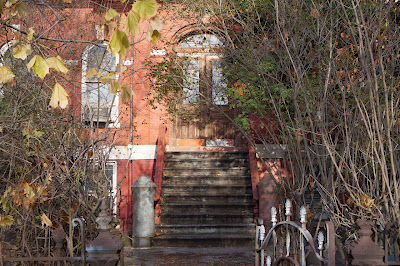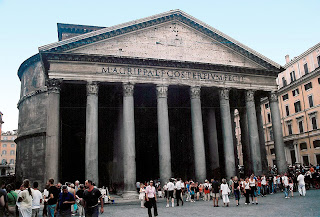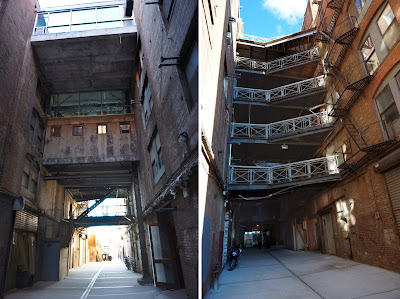 |
| Public Bath on Huron Street Historic Photo - circa 1940 Courtesy of NYC Municipal Archives |
 |
| Public Bath on Huron Street |
 |
| Pitkin Avenue Public Bath |
Most of the public baths in New York City were planned and designed based on recommendations from Dr. Simon Baruch and the Association for the Improvement of the Conditions of the Poor (A.I.C.P.). Dr. Baruch, dubbed "father of the public bath", was a professor of hydrotherapy at Columbia University, an outspoken advocate for public baths and the father of financier Bernard Baruch.[1] Included in the A.I.C.P. recommendations were two standard lot sizes, a preference for "shower baths" over bath tubs and greater capacity for male bathers.[1][6] The A.I.C.P. architects Cady, Berg & See provided two model plans, the "Type A" for small city lots and "Type B" for larger lots.[6][7] The Public Bath on Huron Street was built on the "type B" 50' x 100' lot and its layout is almost identical to that illustrated in the plan of the Pitkin Avenue Public Bath shown above.[6]
The Huron Street Public Bath was built in 1903 at a total cost of $103,724 and opened in 1904.[1][2] Similar to the other public baths in NY built at the turn of the last century, the Public Bath on Huron Street is a Classical Revival style building designed to be “imposing in appearance with an architectural style recalling ancient Roman public baths with classical pilasters, columns, arches and cornices”.[1] The Public Bath was renovated by the WPA in the late 30s along with the other Brooklyn public baths; work included “repairs and replacement of mechanical equipment, new roofing and skylights, new tile walls and floors, new marble enclosures for the showers, replacing the old soapstone stalls, as well as details of outside renovation such as sand blasting and the resetting of entrance steps”[3] The Huron Street bathing facility was steam heated, an amenity that was lacking in the coal fire furnace heated public bath across the creek in Long Island City. When reviewed by a reporter in 1956 the building contained 25 shower stalls for women, 62 for the men and 2 tubs, one on either side of the bathhouse. The layout of the bath included a separate entrance for men and woman with a booth in the middle, which at the Huron Street location offered soap and towel rentals.[4]
At its peak the Huron Street public bath served over a thousand people a day on average but by the time it closed that number had dropped to 25.[5] In 1955 the state law requiring each county to maintain a public bath was amended. After the amendment passed, the Greenpoint bathhouse was no longer mandatory, leaving it vulnerable to city cutbacks.[4] Most of Brooklyn’s public baths closed between 1949 and 1953[5] and by 1956 the Public Bath on Huron Street was the last remaining public bath operating in Brooklyn.[4] The Huron Street facility was decommissioned and closed its doors on December 12th 1960. After closing, the building was eventually auctioned off by the city and is now owned by the proprietor of a custom gilding and framing company (Cowood Gilders) that is operated on the first floor of the building; the building’s second floor is rented out as artist studios.
New York city had a total of 25 public baths, seven of which were located in Brooklyn.[1] With the exception of Public Bath No. 7, the public baths of Brooklyn were designed by either architect Axel S. Hedman or Louis A. Voss.[7] Below is a list that includes all of the Brooklyn public baths, as well as their fate from what I have been able to surmise by using information from various articles and by using Google Streetview.
Brooklyn Public Baths:
Public Bath at 139 Huron Street: Constructed 1903-04 Closed 1960 (Architect Louis H. Voss)
Public Bath at 486 Hicks: Constructed 1903, Demolished in 1941 for construction of the BQE (Architect A. S. Hedman)
Public Bath at 42 Duffield Street near Concorn Street: Constructed 1905, Demolished
Public Bath at Wilson Avenue and Willoughby Avenue: Constructed 1908, Demolished
Public Bath at 1752 Pitkin Avenue: Constructed 1903, Closed 1949 (Architect A. S. Hedman)
Public Bath No. 7 at Presidents Street: Constructed 1906-10 (Architect Raymond F. Aimirail)
Public Bath at 14 Montrose Avenue near Union Avenue: Constructed 1903, Demolished
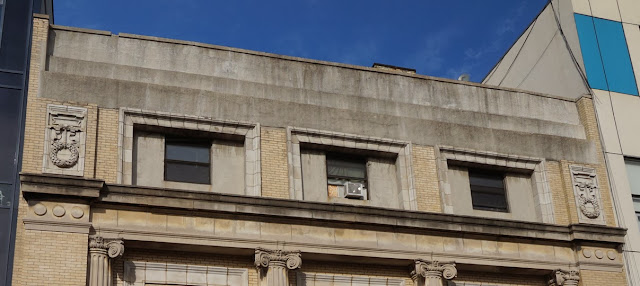 |
| Public Bath Missing Cornice |
Like the PLAV building located on Lenard Street, the cornice of the bathhouse has been removed due to maintenance costs and liability concerns and replaced with concrete. Because of these concerns, as well as local law 11 requiring the repair or removal of any projecting masonry deemed unsafe on all buildings greater than six stories, many cornices on old New York buildings have been removed.
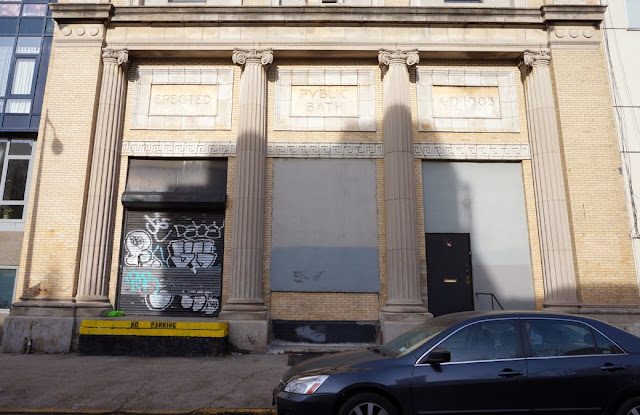 |
| Public Bath on Huron Street Entrances |
 |
| Public Bath on Huron Street Terra cotta Ornamental Detail |
 |
| Pilaster Capital of the Ionic Order |
 |
| Terracotta Detail "Erected" |
 |
| Terracotta Detail "Public Bath" |
 |
| Terracotta Detail "A D 1903" |
References:
- Williams, Marily Thornton Washing "The Great Unwashed" Public Baths in Urban America 1840-1920. Columbus: Ohio State University Press, 1991
- Robinson, George “Cold-Water Flat Days” New York Times Online. 4 January, 2004
- Corby, Jane “S.R.O. Days of Yore Appear Gone Forever” Brooklyn Daily Eagle.
- Milburn, Terry “Soaps Up a Story in a City Sudsatorium” Daily News. 5 February 1956
- “Last Public Bath Is a Washout” no citation given. 17 December 1960
- Gerhard, William Modern Baths and Bathhouses New York: John Wiley & Sons, 1908
- New York City Landmarks Preservation Commission. Public Bath No. 7 Designation Report. New York 11, September 1984.


